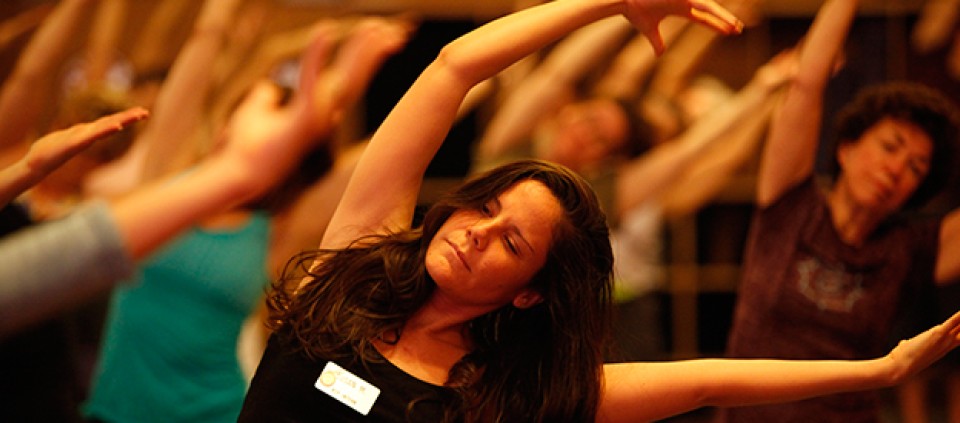Why Yoga Increases Feelings of Connection

While many people turn to yoga to reduce stress, an equal number go to yoga class in order to experience a greater sense of connection—with themselves and with each other. We come in to class feeling separate, disconnected, even resentful (Why did she put her mat so close to mine?). We leave smiling, warmed by each other (Hope I see her again next week!). Why? According to research, yoga may increase feelings of social connection in several key ways.
Yoga enhances body systems related to social connection.
Research shows that can yoga improve the function of the vagus nerve, a key nerve in stress resilience. People with low vagal tone tend to have trouble recovering from stressful events, while people with high vagal tone tend to recover with greater ease (see other blog). In addition to indicating one’s level of resilience against stress, vagal tone is also correlated with feelings of social connection. The greater your vagal tone, the greater your perceived sense of connection.
What does this have to do with yoga? For one, there’s a growing body of research showing that yoga improves vagal tone. Loving-kindness meditation (in which you actively send good wishes to yourself and others) has been shown to improve both vagal tone and feelings of social connection. Bottom line? From a physiological perspective, yoga may increase feelings of bonding because it improves vagal tone.
Synchronized movement creates bonding.
Research points to another possible explanation of why yoga increases feelings of social connection: the impact of synchronized movement. Studies suggest that, as a group of yoga students breathes and moves together, a mental synchronization is taking place as well. As our bodies synch, our brains may be synching, too. You leave class feeling a part of something larger than yourself, because your brain has been part of something larger than itself—kind of like a big, happy mind-meld.
Positive Psychology researcher Barbara Fredrickson, author of Love 2.0, states, “What we’ve learned is that when people move together as one orchestrated unit, they later report that they experienced an embodied sense of rapport with each other—they say they felt alive, connected, with a mutual sense of warmth and trust as they converse. Other studies concur. When synchrony is surreptitiously produced in experimental studies—by having people walk, tap, sing, sway, or rock together in time—it breeds liking, cooperation, and compassion as well as success in joint action.” Shared movement increases a sense of union and thus enhances feelings of social support and connection.
Presence increases connection.
A final ingredient in the formula: presence. It turns out that the ability to be fully present in the moment has a powerful effect on social bonding. When we’re fully present with another person, we increase the likelihood of experiencing a sense of union and connection. Without presence, those benefits are watered down.
This has become particularly notable in recent research on brains, synchrony, and communication. Brain-imaging studies show that when a person is talking, the listener’s brain begins to synch with the speaker’s brain. Gradually, their brains begin to fire simultaneously. Eventually, with presence, the listener’s brain can even start to predict how the speaker’s brain will fire and begin to fire before it. This only happens through mindful attention; if you only half-listen, your brain will only partially synch. Barbara Fredrickson writes, “Far from being isolated to one or two brain areas, really ‘clicking’ with someone else appears to be a whole brain dance in a fully mirrored room.”
A key brain region in this “mind-meld” is the insula, a part of the brain related to conscious feeling states. It will be no surprise to yoga practitioners that the insula is the same region of the brain that is activated through mindfulness meditation. It appears that mindfulness meditation—being present to the current moment—as is so often taught in yoga class, augments feelings of social connection and attunement by activating the insula and increasing brain synchrony. Through mindfulness meditation, we open ourselves to feelings of deeper interconnection and belonging.
Yoga means union, and, with this growing body of research, scientists have a way to understand how and why that union arises. We know that the experience of connection can be cultivated, and that it has far-reaching effects on the body and mind. In a culture that tends toward isolation, this is indeed a precious gift.
© Kripalu Center for Yoga & Health. All rights reserved. To request permission to reprint, please e-mail editor@kripalu.org.
Angela Wilson, LMHC, RYT 500, is a Kripalu faculty member who has conducted research and written about the intersection between yoga, Western psychology, and science.
Full Bio and Programs